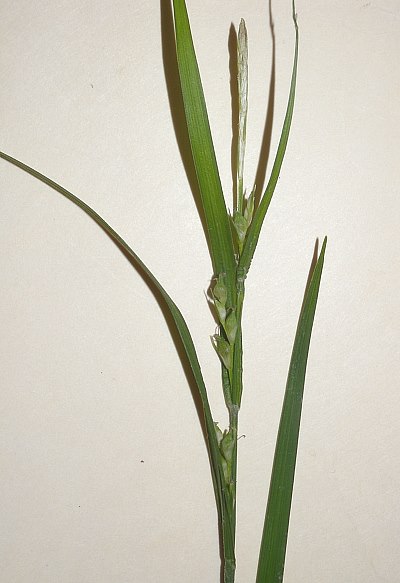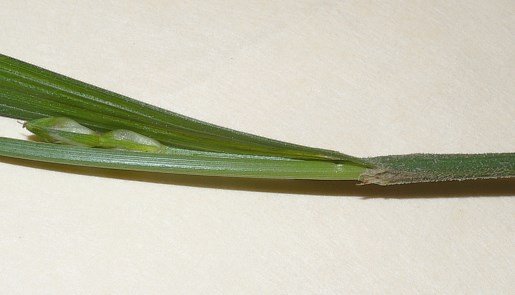Description: This perennial sedge is 1–2½' tall, forming small tufts of culms with alternate leaves. Each culm is light to medium green, sharply 3-angled, and hairless. About 2-4 leaves occur along the length of each culm. The leaf blades are up to 12" long and 3-7 mm. across; they are medium green and hairless (or nearly so), usually spreading outward from the culm in arching curves. The leaf sheaths are medium green, vertically veined, and short-pubescent.

Each culm
terminates in an inflorescence consisting of 2-4 lateral pistillate
(female) spikelets, a terminal staminate (male) spikelet, and their
leafy bracts. The pistillate spikelets are ¼–1" long, consisting of 2-8
perigynia and their pistillate scales; these spikelets are held erect
on short slender peduncles. The perigynia and their scales are
distributed somewhat sparsely along the length of each spikelet. The
perigynia are 4.0–5.5 mm. long, 2.0 mm. across, obovoid, finely veined,
and glabrous. At the apex, each perigynium has a short beak (about 1
mm. long) that is slightly curved, while the base of the perigynium
tapers gradually to a wedge-like shape. The pistillate scales are as
long or longer than their perigynia. Each pistillate scale is ovate and
long-awned; it is largely white-membranous at the bottom and
green-veined in the center. The
slender staminate spikelet is ¾–1½" long, varying in color from
membranous-white to tan; it is held erect on a slender peduncle about
¼–1" long. At the base of each pistillate spikelet, there is a large
leafy bract that closely resembles the leaves below. These leafy bracts
are sufficiently long to overtop the inflorescence. The blooming period
occurs from late spring to early summer; the florets are
cross-pollinated by the wind. The achenes are 2.5–3.5 mm. long,
obovoid, bluntly 3-angled, and glabrous. The root system is
short-rhizomatous and fibrous.
Cultivation:
The preference is dappled sunlight to medium shade, mesic conditions,
and rich soil (loam or rocky loam) containing some organic matter.
Range & Habitat:
The native Hitchcock's Sedge is found primarily in central and northern
Illinois,
where it is uncommon and local. Habitats include mesic deciduous
woodlands, rocky woodlands, bluffs, and slopes of bluffs. This sedge is
found in above-average to high quality natural areas.
Faunal Associations:
Various insects feed on woodland sedges (Carex spp.), including the
caterpillars of Satyrodes appalachia (Appalachian
Brown), caterpillars of some moths, leafhoppers (primarily Cosmotettix
spp.), and the stink bug Mormidea lugens. The seeds
are eaten by the Wild Turkey, young Ruffed Grouse, Eastern Towhee,
Common Redpoll, and Slate-Colored Junco. Woodlands sedges are a minor
source of food to some mammals. For example, the Black Bear and
White-Tailed Deer eat the foliage and spikelets, Gray Squirrel and Fox
Squirrel eat the seeds and spikelets, and the Common Mole reportedly
feeds on the roots (Martin et al., 1951/1961).
Photographic Location:
The photographed sedge was taken from a bluff in Vermilion County,
Illinois.

Comments: This lanky woodland sedge has a leafy appearance from top to bottom. It differs from many other woodland sedges by the relatively large size of its perigynia and scales, the odd shape of its perigynia, the long awns of its pistillate scales, and its pubescent sheaths. The most similar sedge, Carex oligocarpa (Few-Fruited Sedge), differs from Hitchcock's Sedge by its smaller perigynia and achenes, and its hairless sheaths. Both of these species are found in wooded areas.